COMBAT SEQUENCES OF WAHNAM TAIJIQUAN
(Original Verson)
Overview
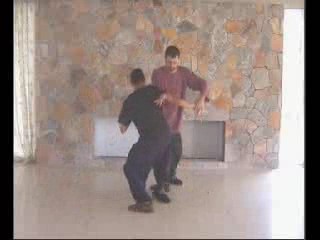
Sifu Jeffrey Segal uses "Lazy to Roll up Sleeves" to twist the opponent's arm to his back, and Sifu Javier Galve counters with "Carry Tiger Back to Mountain"
To further our effort to help Taijiquan practitioners to spar or fight using Taijiquan, we release the following video clips, still pictures and explanations on our Wahnam Taijiquan combat sequences. Combat sequence training is an important link enabling practitioners to apply their combat skills and techniques for free sparring or real fighting.
The twelve combat sequences released below were demonstrated by Sifu Jaffrey Segal of Australia and Sifu Javier Galve of Spain in 2002 immediately after their Special Taijiquan Course with Sifu Wong in Malaysia. If practitioners are already trained in basic Taijiquan skills like correct spacing and correct timing, and basic techniques like ward offs and palm strikes, they will be able to spar or fight after undergoing combat sequence training. On the other hand, if they merely learn the combat sequences but have no basic skills or techniques, their combat application will not be effectual.
In Wahnam Taijiquan, basic combat skills are developed through Pushing Hands, and basic combat techniques that cover all the four major categories of attacks and defences are learnt in Striking Hands. Wahnam Taijiquan students who are not yet familiar with these basic combat skills and techniques can refer to the eight series of Pushing Hands starting wtih Basic Techniques and Skills and the eight series of Striking Hands starting with Basic Striking Techniques and Defence .
To have a better understanding and more effective application of Taijiquan for combat, it is helpful to appreciate the following points:
-
As revealed in the video clips, combat training can, in fact should, be elegant and pleasant, and sparring partners should not be hurt, which actually is the main reason for the training. Expecting and accepting to be hit and kicked during combat training, which unfortunately is very common today, shows what a ridiculous situation Taijiquan or any martial art has been debased into.
-
Taijiquan is an internal martial art, which means that a Taijiquan practitioner can, in fact should, be relaxed and graceful yet powerful. If he uses boxing gloves or weight lifting in his training, for example, it suggests that he does not understand the philosophy of internal art training.
-
Taijiquan is a complete martial art, which means that without having to borrow from other martial art techniques, by itself Taijiquan is capable of handling any attacks. If a Taijiquan practitioner does not know how to counter a take-down or a throw, for example, it is not because there are no such counters in Taijiquan but simply because he does not know.
-
The combat training will enable you to apply Taijiquan effectively in free sparring or real fighting. It does not necessarily mean you will surely defeat your opponent in a fight. Whether you will defeat him depends on a few other factors, like whether he is better trained than you and whether he has a lot of fighting experience. But it is certain that with the combat training you will be a better fighter, and more significantly a better person, than what you would be had you just rushed into free sparring in the hope of learning self-defence.
The 12 Combat Sequences (Original Verson) are as follows:
- Immortal Waves Sleeves
- Punch Belw Sleeves
- White Snake Shoots Venom
- Golden Dragon Shoots Peral
- White Crane Flaps Wings
- Low Stance Single Whip
- Thrust Kick
- Move, Ward Off and Punch
- Black Bear Sinks Hips
- Shoulder Strike
- Cloud Hands
- Carry Tiger Back to Mountain
1 Immortal Waves Sleeves
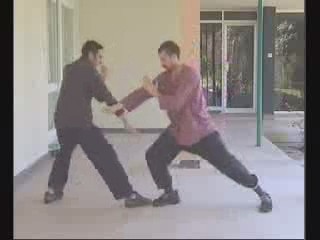 1. Immortal Waves Sleeves
1. Immortal Waves Sleeves
Some basic attacking and defending patterns are used in this sequence where the combatants employ appropriate "shen-fa" or body movement rather than moving their feet. Without proper stances, it is not possible to use this tactical advantage, which is very important in Taijiquan to implement the principle of "using minimum force against maximum strength".
Video
2 Punch Below Sleeves
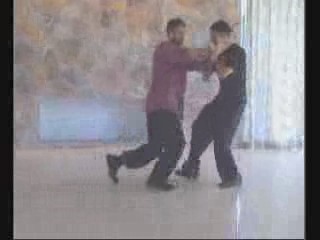 2. Punch Below Sleeves
2. Punch Below Sleeves
In this sequence the combatants learn to move forward and backward keeping correct spacing and correct timing. The tactic of “one hand against two” is also introduced.
Video
3 White Snake Shoots Venom
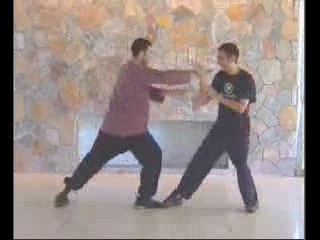 3. White Snake Shoots Venom
3. White Snake Shoots Venom
Here the combatants learn different ways of applying the same attack and defence. They use appropriate body movement to maximize result.
Video
4 Golden Dragon Shoots Pearl
 4. Golden Dragon Shoots Pearl
4. Golden Dragon Shoots Pearl
When your opponent moves forward, it is not always necessary to retreat. You can “sink” down and then press back in return. This is an effective counter against an opponent using a pressing tactic against you.
Video
5 White Crane Flaps Wings
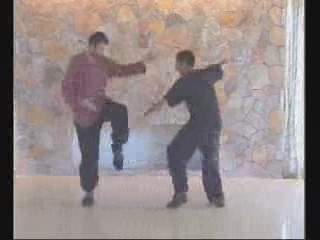 5. White Crane Flaps Wings
5. White Crane Flaps Wings
A deadly kick is introduced here. It may be interesting to note that the defender uses the same pattern used by the attacker, but in a different way to counter the attack.
Video
6 Low Stance Single Whip
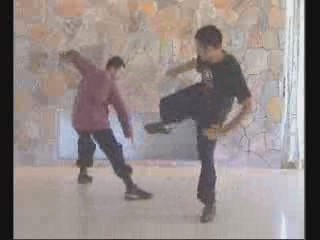 6. Low Stance Single Whip
6. Low Stance Single Whip
A different kicking attack is introduced in this sequence. Here you will learn a simple Taijiquaqn pattern that can be used to defend against all kinds of kicks.
Video
7 Thrust Kick
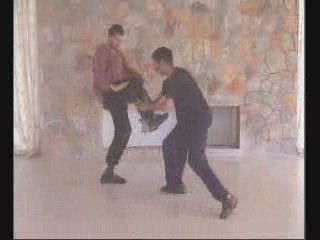 7. Thrust Kick
7. Thrust Kick
A third kicking attack is introduced. You will also learn how to counter if your kicking leg is caught by an opponent.
Video
8 Move, Ward Off and Punch
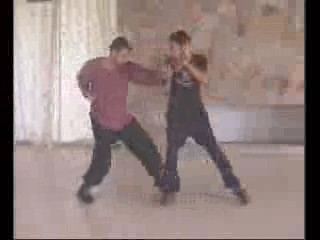 8. Move, Ward Off and Punch
8. Move, Ward Off and Punch
This sequence shows a counter against a knee strike, applying a famous tactic frequently used in Taijiquan called "lian xiao dai da", where the counter attack runs together with the defence. This Taijiquan pattern can be used against a sweeping kick as well as many other forms of attack.
Video
9 Black Bear Sinks Hips
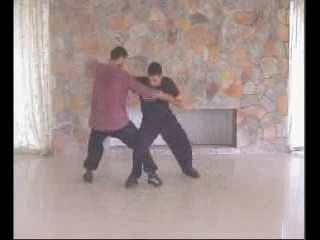 9. Black Bear Sinks Hips
9. Black Bear Sinks Hips
A throwing attack and its counter are introduced here. A good stance is necessary for their application.
Video
10 Shoulder Strike
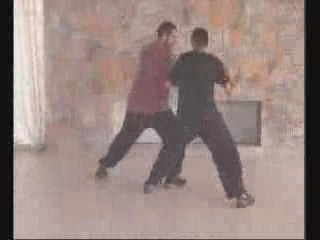 10. Shoulder Strike
10. Shoulder Strike
“Qin-na”, which is a special way of gripping attack, is introduced here. This sequence also illustrates the famous Taijiquan principle of “flowing with the opponent's attack”, and the tactic of “long against short”.
Video
11 Cloud Hands
 11. Cloud Hands
11. Cloud Hands
“Cloud Hands”, which is a well known but little understand Taijiquan pattern, is employed here to counter “qin-na” or specialized gripping attack. The famous Taijiquan tactic, "lian xiao dai da" or “defence cum attack”, is also illustrated.
Video
12 Carry Tiger Back to Mountain
 12. Carry Tiger Back to Mountain
12. Carry Tiger Back to Mountain
All the four categories of attack — striking, kicking, felling and gripping — are found in this short sequence, concisely highlighting that Taijiquan is a complete martial art. Some common patterns are also used in ways that many students may not have thought them possible.
Video
LINKS
Revised Version of Taijiquan 12 Basic Sequences
